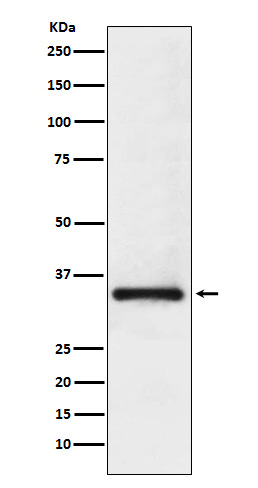
| WB | 咨询技术 | Human,Mouse,Rat |
| IF | 1/20-1/50 | Human,Mouse,Rat |
| IHC | 咨询技术 | Human,Mouse,Rat |
| ICC | 1/50-1/200 | Human,Mouse,Rat |
| FCM | 咨询技术 | Human,Mouse,Rat |
| Elisa | 咨询技术 | Human,Mouse,Rat |
| Aliases | Mud1; snRNP A; SNRPA; U1-A; U1A;;U1A |
| WB Predicted band size | 31 kDa |
| Host/Isotype | Rabbit IgG |
| Antibody Type | Primary antibody |
| Storage | Store at 4°C short term. Aliquot and store at -20°C long term. Avoid freeze/thaw cycles. |
| Species Reactivity | Human,Mouse,Rat |
| Immunogen | A synthesized peptide derived from human U1A |
| Formulation | Purified antibody in PBS with 0.05% sodium azide,0.05% BSA and 50% glycerol. |
+ +
以下是关于U1A抗体的3篇参考文献及其摘要内容的简要列举:
1. **"Autoantibodies to U1 small nuclear ribonucleoprotein (snRNP) in systemic lupus erythematosus"**
*作者:Hoch SO, et al.*
**摘要**:该研究分析了系统性红斑狼疮(SLE)患者中针对U1 snRNP组分的自身抗体,发现U1A蛋白是主要抗原靶点之一。实验表明,U1A抗体可能与疾病活动性及特定临床症状(如肾炎)相关。
2. **"Epitope mapping of the U1 small nuclear ribonucleoprotein particle using monoclonal antibodies"**
*作者:Barakat S, et al.*
**摘要**:通过单克隆抗体技术,作者定位了U1 snRNP中U1A蛋白的抗原表位,揭示了其与RNA结合区域的重叠,提示抗体可能干扰RNA剪接功能,为理解自身免疫反应的致病机制提供依据。
3. **"Clinical significance of anti-U1 RNP antibodies in connective tissue diseases"**
*作者:Hoffman RW, et al.*
**摘要**:该文献探讨了抗U1 RNP抗体(包含U1A抗体)在混合性结缔组织病(MCTD)和SLE中的临床意义,指出其与雷诺现象、肺动脉高压等临床表现的相关性,并讨论了抗体滴度与预后的关系。
**注**:以上信息基于公开研究内容的概括,部分细节(如作者或年份)可能存在简化或误差,建议通过PubMed等数据库核实原文。
U1 antibodies, specifically targeting components of the U1 small nuclear ribonucleoprotein (snRNP) complex, are autoantibodies primarily associated with autoimmune disorders. The U1 snRNP is a critical spliceosome component involved in pre-mRNA processing. The U1A (anti-U1-70kD) antibody recognizes the 70kD protein within this complex and is a hallmark of mixed connective tissue disease (MCTD), where it often coexists with anti-U1-RNP (anti-Smith antigen) antibodies. It is also detected in subsets of systemic lupus erythematosus (SLE), systemic sclerosis, and rheumatoid arthritis.
Clinically, U1A antibodies contribute to diagnosis and disease stratification. High titers are strongly linked to MCTD, characterized by overlapping features of SLE, scleroderma, and polymyositis. Their presence may correlate with specific manifestations, such as Raynaud’s phenomenon, pulmonary hypertension, or arthritis. Detection methods include ELISA, immunoblot, or immunofluorescence.
Pathogenically, U1A antibodies may arise from molecular mimicry or epitope spreading triggered by viral infections or genetic susceptibility (e.g., HLA-DR4). They can form immune complexes, driving inflammation and tissue damage. However, their direct role in disease mechanisms remains unclear, as U1 snRNP disruption might impair RNA splicing, affecting cellular functions. Research continues to explore their prognostic value and therapeutic implications in autoimmune diseases.
×